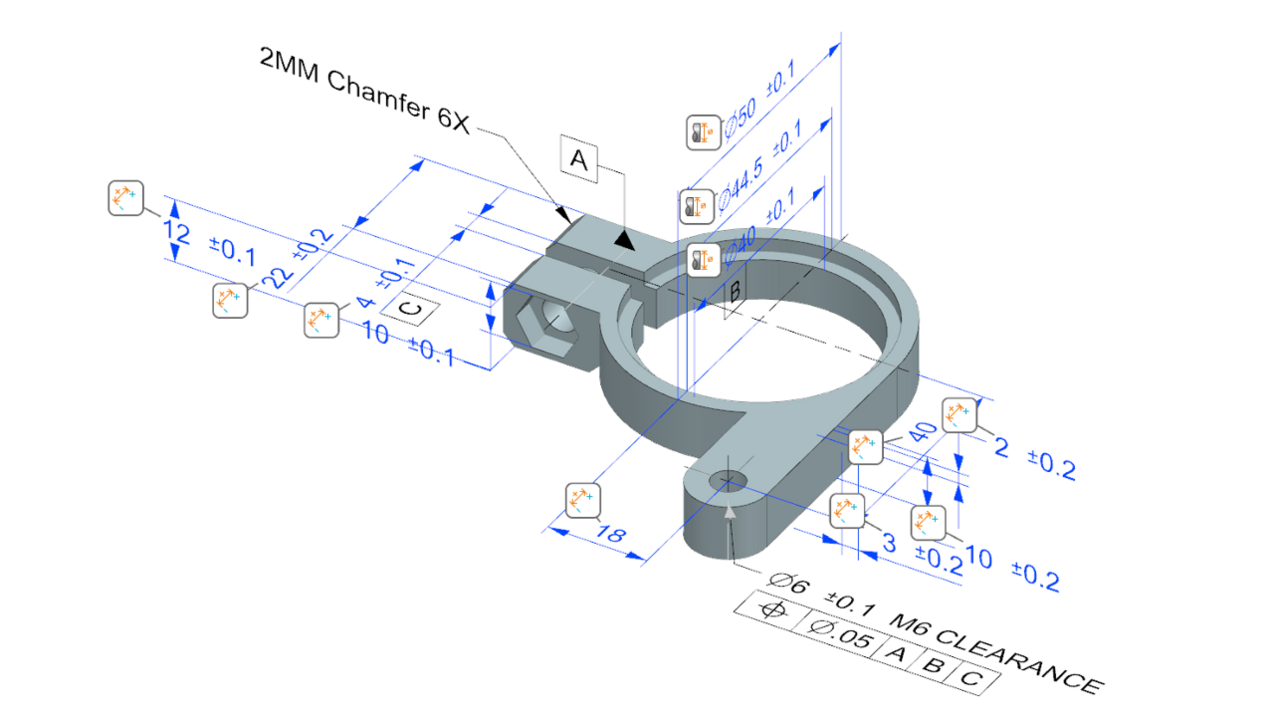Let's dive into the fascinating world of digital transformation in manufacturing and design, highlighting major advances in AI, particularly in manufacturing. With a focus on the concrete benefits that AI brings to designers, engineers, and manufacturers, we'll also explore how renowned software such as Siemens NX is revolutionizing computer-aided design (CAD/CAM) with the help of Artificial Intelligence.
AI in industrial digital transformation: State of play
Overview of progress and prospects of AI related to industry & CAD/CAM

Understanding AI: Types and applications
Artificial Intelligence, or AI, encompasses a range of technologies designed to endow machines with intellectual capacities similar to those of humans. There are two types of AI: soft AI, specialized in specific tasks, and hard AI, capable of generalizing its skills to various fields. In recent years, numerous advances have been made, particularly in the fields of machine learning and computer vision.
AI and its many faces: From recognition to machine learning
Before diving into the details, it's crucial to understand the diversity of AI. Image recognition systems enable machines to "see" and visually interpret the world, while machine learning gives computers the ability to learn from data and improve over time. These two facets, among others, are converging to transform the way we design and manufacture. Let's take a look at the different types of AI that exist:
-
Soft AI (or Specialized AI) :
- Designed for a specific, limited task, weak AI excels in restricted domains. It cannot generalize its skills to other contexts.
- Example: Voice recognition systems (such as Apple's Siri or NX Voice Command Assist)
-
Hard IA (or IA General) :
- Unlike soft AI, hardAI is designed to generalize its skills to various domains, similar to human cognitive capacity.
- Example: A system capable learning and performing in a variety of domains, from image recognition to complex problem solving.
-
Reactive AI :
- Computer program that responds in a predefined way to specific situations without being able to learn new information.
- Example: Computer chess, which follows predefined rules for each possible move.
-
AI for Machine Learning :
- Machine learning systems use algorithms to enable machines to learn from data and improve their performance over time.
- Example: recommendation algorithms, where the system learns the user's preferences from past actions.
-
Deep Learning AI:
- A sub-category of machine learning, deep AI uses artificial neural networks composed of many layers (hence the term "deep").
- Example: Deep neural networks are used in image recognition, machine translation and other applications.
-
Symbolic AI :
- It manipulates symbols using logical rules to perform complex tasks, often associated with a knowledge-based approach.
- Example: Expert systems used to diagnose medical problems based on logical rules.
-
Evolutionary AI (or Genetic AI) :
- Inspired by biological evolution, this approach uses genetic algorithms to solve complex problems by progressively evolving solutions.
- Example: Optimizing the design of complex structures, as in aeronautics.
-
Quantum AI:
- Uses the principles of quantum mechanics to perform more complex calculations and process massive data sets more efficiently than conventional computers.
- Example: Searching for optimal solutions in fields such as cryptography or supply chain optimization.
This illustrates the diversity of approaches and capabilities of Artificial Intelligence, showing how it can be specialized or generalist, reactive or learning, rules-based or deep learning, and even influenced by cutting-edge fields such as quantum computing.
AI in manufacturing: Concrete benefits
The tangible benefits of AI in the manufacturing industry are undeniable. Companies have adopted AI-based solutions to optimize production planning, reduce downtime through predictive maintenance, and improve product quality through automated defect detection. These advances not only contribute to increased productivity, reduced costs and operational agility, but also to companies' overall competitiveness.

Design revolution: Siemens NX at the forefront
CAD/CAM software, such as Siemens NX, embodies the evolution of AI in design. Siemens NX integrates advanced AI functionalities to make the design process more intelligent and efficient. For example, the software can anticipate the next design steps by analyzing previous schematics, speeding up the workflow and reducing the time needed to go
Siemens NX also excels at optimizing design processes. Built-in AI algorithms can suggest design modifications based on predefined criteria, enabling designers to make informed decisions. What's more, thefrom idea to realization.
software offers advanced simulation capabilities that can predict a product's behavior under real-world conditions, providing accurate virtual validation.
Production optimization: Smarter digital chains
One of the areas where AI has brought about significant change is production optimization. Thanks to sophisticated algorithms, companies can now forecast demand based on the analysis of previously untapped data, adjust production in real time and minimize costs while maximizing efficiency. Intelligent machines, connected to each other with the emergence of the IoT, form dynamic production chains capable of self-adjusting in response to market fluctuations.

Predictive maintenance: Reducing downtime
The introduction of AI-based predictive maintenance has been a revolution for industrial asset management. By analyzing equipment data in real time, predictive systems can anticipate impending failures, enabling targeted interventions before major problems arise. Precise anticipation translates into a significant reduction in unscheduled downtime, improved equipment availability, and extended asset life !


Improved quality control: automated fault detection
AI has also revolutionized quality control by introducing automated defect detection systems. Machines equipped with computer vision capabilities can thoroughly inspect products at high speed, identifying imperfections with exceptional accuracy. This not only improves the quality of final products, but also reduces the costs associated with rejects and returns.
Intelligent supply chains : Anticipating needs
In the field of supply chain management, AI offers advanced forecasting and optimization functionalities. Manufacturers can anticipate raw material requirements, optimize stock levels, and minimize logistics costs thanks to predictive algorithms. This proactive approach strengthens the resilience of supply chains, even in unstable market contexts.

Concrete examples of benefits in Siemens NX
A concrete example of the benefits of Siemens NX is the automatic generation of complex geometries. AI algorithms analyze previous designs, identify recurring patterns, and automatically generate optimized geometric shapes according to project constraints and objectives. But that's not all:
-
The integrated algorithmic modeling module in Siemens NX opens the door to surprising designs in an iterative and intuitive way. This new design model simplifies complex design processes by allowing designers to describe the "intent" of their design with rules and logic to define its fundamental characteristics, such as thickness, twist or taper of an object, product or even a building.
- The Selection Prediction and Select Similar commands use Artificial Intelligence (AI) and Machine Learning (ML) for pattern recognition to quickly identify geometrically similar components.
-
With AI, the user interface becomes more personalized and predicts your needs. A new technology integrated a few years ago, based on machine learning (ML), this function predicts commands based on NX usage and the user model. It collects data as you interact with the system and uses this data as a regular source of learning data. The adaptive user interface then proposes one or more choices in the order best suited to the task in hand.
-
NX CAD/CAM software also comes with NX Voice Command Assist, a "soft AI" as explained above. This assistant enables the user to execute commands, navigate menus and perform multi-level operations. In addition to basic commands, the user can teach the system words or phrases to perform common tasks. For example, ask NX: "Have we ever created anything like this ?", and it will perform a shape search using Siemens Geolus® technology.
Outlook: Towards an intelligently connected industrial future
As we celebrate past successes, the future of AI in manufacturing and design looks even brighter. The coming months and years are likely to see further integration of AI into manufacturing processes, with a particular focus on intelligent automation and system interoperability. Human-machine collaboration will also be at the heart of developments, enabling optimum synergy between human and artificial intelligence.
Artificial Intelligence has profoundly changed the way we design and manufacture. The benefits are palpable, from optimized production lines to the unbridled creativity of designers. As we look to the future, it's clear that AI will continue to catalyze innovation, paving the way for an era where Human/Machine complementarity, human and artificial intelligence will become the norm.
In brief
In conclusion, Siemens NX and other leading software demonstrate that AI is not just a trend, but a tangible reality that is profoundly transforming the way we design and manufacture. As we look ahead to the coming months and years, we can expect to see even further integration of AI into CAD & CAM software, with innovative features that will continue to set industry standards.
The symbiosis between AI and computer-aided design represents an exciting new chapter in the history of engineering.
At Janus Engineering, we explore these emerging possibilities and collaborate with our peers to contribute to shaping a future where intelligent technology and human creativity converge harmoniously. We are ready to embrace these changes and together shape the future face of manufacturing and design !
Find out more
White Paper
Artificial Intelligence on the shopfloor
Envisioning the future of intelligent automation and its impact on manufacturing.
Video
Want to know more about NX's algorithmic modeling tool ?
Our application engineer Alexis Capoen tells you all about it in a short video.
Topics:
Subscribe to our blog
Tips and news around digital manufacturing.
 Henri VAAST
Henri VAAST  Henri VAAST
Henri VAAST

